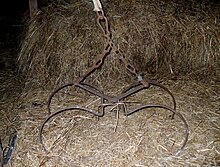Hay elevator
A hay elevator is used to store loose dry material , especially hay , in barns and haylofts . The labor-intensive hay lifts have mostly been replaced by hay blowers or hay cranes since the introduction of the loading wagon .
construction
A hay elevator consists of a gripper attached to a trolley by a cable . The trolley runs on a rail fastened under the roof ridge . A hay elevator is driven by a winch that is located at one end of the rail with an electric motor, only older hay elevators have to be moved with muscle power.
A hay elevator can only pick up the hay at the end of the rail opposite to the drive. Some hay lifts are only inside the building, with some hay lifts the place where the hay is picked up is outside the building. The rail protruding outwards through a gate is attached to a bar, the so-called hay bar.
functionality
First the trolley drives to the end of the rail. There the gripper releases automatically and it lowers itself to the dry material to be stored in the barn or on the hayloft, which is usually on a trailer. After closing the gripper, it is pulled back up to the trolley, where it engages. The trolley then moves on the rail to the previously set unloading point. There the gripper is opened and the dry crop falls to the ground, from where it still has to be distributed over the entire storage area using a pitchfork .
literature
- Hay elevator. In: Otto Lueger: Lexicon of the entire technology and its auxiliary sciences. Vol. 5, Stuttgart, Leipzig 1907, p. 56
